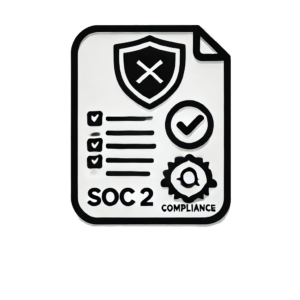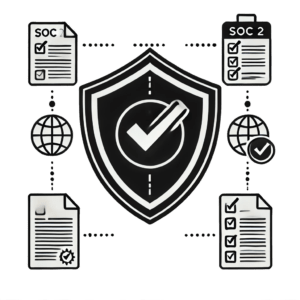Synopsis of SOC Reports: SOC 1 vs SOC 2

When it comes to understanding the differences between SOC 1 and SOC 2 reports, businesses must be cognizant of the unique aspects each report covers. SOC 1 reports, also known as SSAE 18 reports, focus on internal controls over financial reporting. These reports are crucial for service organizations that impact their clients’ financial statements. In contrast, SOC 2 reports center around security, availability, processing integrity, confidentiality, and privacy controls. They are vital for technology and cloud computing service providers to showcase their system’s security measures and compliance.
The key differentiator between SOC 1 and SOC 2 reports lies in their scope and focus. While SOC 1 reports address financial reporting controls, SOC 2 reports delve into operational and compliance controls related to IT and data security. Both reports play a crucial role in providing assurance to clients and stakeholders regarding the effectiveness of controls implemented by service organizations.
Ultimately, understanding these differences is essential for businesses to choose the appropriate SOC report that aligns with their specific needs and industry requirements. By grasping the nuances of SOC 1 and SOC 2 reports, organizations can demonstrate their commitment to security, compliance, and trustworthiness in today’s complex digital landscape.
Importance of SOC Reports
SOC reports are critical for businesses looking to demonstrate their commitment to data security and compliance. These reports provide valuable insight into the effectiveness of an organization’s internal controls and help stakeholders assess the risks associated with their operations. SOC reports also play a crucial role in building trust with clients, partners, and regulators by showcasing the company’s dedication to maintaining a secure and reliable environment for sensitive data.
When it comes to SOC 1 vs SOC 2 reports, businesses must understand the key differences to determine which type of report best suits their needs. SOC 1 reports focus on controls relevant to financial reporting, making them ideal for service providers that handle their clients’ financial data. On the other hand, SOC 2 reports assess controls related to security, availability, processing integrity, confidentiality, and privacy, making them more suitable for organizations that store and process sensitive information.
Overall, SOC reports are essential tools for businesses seeking to enhance their cybersecurity posture, streamline compliance efforts, and reassure stakeholders of their commitment to protecting sensitive data.
Understanding SOC 1 Reports
Understanding the difference between SOC 1 and SOC 2 reports is crucial for businesses seeking to assess and demonstrate their control over financial reporting and security practices. SOC 1 reports focus on controls relevant to financial reporting, specifically evaluating the effectiveness of a service organization’s internal controls that impact their clients’ financial statements. This report is important for businesses that outsource processes that are likely to impact their financial reporting. On the other hand, SOC 2 reports address controls related to security, availability, processing integrity, confidentiality, and privacy. These reports are valuable for organizations relying on third-party service providers to protect their data and systems.
While both SOC reports are essential for different purposes, understanding their distinctions is vital for choosing the right assessment for your organization’s needs. SOC 1 is often suitable for businesses that provide services impacting financial reporting, while SOC 2 is more relevant for companies seeking assurance on their security and data protection measures. By comprehending the nuances between SOC 1 and SOC 2 reports, businesses can make informed decisions to enhance their overall risk management and compliance strategies.
Application of SOC 1 in Businesses
When it comes to assessing and demonstrating controls related to financial reporting, SOC 1 reports play a critical role in businesses. SOC 1, also known as Service Organization Control 1, focuses on the internal controls over financial reporting within organizations. This type of audit report is especially relevant for businesses that provide services impacting their clients’ financial statements.
Through SOC 1 audits, businesses can provide assurance to their clients and stakeholders regarding the effectiveness of their financial reporting controls. It helps in building trust and credibility by demonstrating that the necessary safeguards are in place to ensure the accuracy and reliability of financial information.
Businesses that process transactions, manage payroll, or handle sensitive financial data for clients can benefit greatly from undergoing SOC 1 audits. By obtaining a SOC 1 report from a reputable auditing firm, organizations can showcase their commitment to maintaining high standards of financial control and security.
Overall, the application of SOC 1 in businesses is essential for ensuring transparency and accountability in financial reporting processes, ultimately strengthening relationships with clients and stakeholders.
Exploring SOC 2 Reports
When it comes to assessing a service provider’s control environment, understanding the difference between SOC 1 and SOC 2 reports is crucial for businesses seeking assurance around data security and privacy practices. SOC 1 reports focus on controls relevant to financial reporting, while SOC 2 reports concentrate on controls related to security, availability, processing integrity, confidentiality, and privacy. For businesses entrusting their data to third-party service providers, SOC 2 reports provide valuable insights into the effectiveness of controls that impact the security and privacy of their sensitive information.
Organizations should carefully evaluate which type of report best aligns with their specific needs and requirements. While SOC 1 reports are suited for businesses that rely on outsourced services impacting their financial statements, SOC 2 reports offer a broader assessment of controls that are essential for safeguarding sensitive data. By leveraging the information contained in SOC 2 reports, businesses can make informed decisions regarding the security posture of their service providers, ultimately mitigating risks related to data breaches and ensuring compliance with industry regulations.
Use of SOC 2 in Businesses
When it comes to evaluating the security measures of service providers, businesses often come across terms like SOC 1 and SOC 2. While SOC 1 focuses on controls related to financial reporting, SOC 2 compliance is specifically designed to address the security, availability, processing integrity, confidentiality, and privacy of a system. For businesses looking to ensure the security and integrity of their operations, achieving SOC 2 compliance is crucial as it offers a framework for safeguarding sensitive data and maintaining customer trust.
SOC 2 reports provide detailed information on the effectiveness of a service provider’s controls related to security, availability, and confidentiality. By obtaining a SOC 2 report from their vendors, businesses can gain valuable insights into the internal processes and controls implemented by the service provider. This transparency helps businesses assess the risks associated with outsourcing services and make informed decisions about their partnerships.
Overall, SOC 2 plays a vital role in enhancing trust and credibility between businesses and their service providers. It demonstrates a commitment to security best practices and provides assurance that the service provider has implemented adequate measures to protect sensitive data. With data breaches on the rise, SOC 2 compliance is no longer just a differentiator but a necessity for businesses operating in today’s digital landscape.
SOC 1 vs SOC 2: Key Differences
Variances in Purpose and Scope
When comparing SOC 1 and SOC 2 reports, one of the key distinctions lies in their purpose and scope. SOC 1 reports, also known as SSAE 18 reports, are designed to evaluate and report on the internal controls over financial reporting at a service organization. These reports are critical for businesses that outsource processes impacting their clients’ financial statements, providing assurance on the effectiveness of these controls. On the other hand, SOC 2 reports focus on the controls relevant to security, availability, processing integrity, confidentiality, and privacy of a system. This broader scope makes SOC 2 reports more suitable for service organizations that handle sensitive customer data or provide cloud-based services. Understanding the nuances in the purpose and scope of SOC 1 and SOC 2 reports is essential for businesses to choose the most appropriate report based on their specific needs and requirements.
Differences in Evaluation Criteria
Understanding the differences in evaluation criteria between SOC 1 and SOC 2 is crucial for businesses seeking to enhance their cybersecurity posture. SOC 1, also known as SSAE 18, focuses on controls relevant to financial reporting, making it ideal for businesses that handle financial transactions and data. On the other hand, SOC 2 evaluates controls related to security, availability, processing integrity, confidentiality, and privacy, offering a more comprehensive assessment of a company’s overall security posture.
While SOC 1 primarily assesses the effectiveness of internal controls over financial reporting, SOC 2 dives deeper into the operational effectiveness of security controls, making it valuable for service organizations that store sensitive customer data. Additionally, SOC 2 reports are more detailed and provide a higher level of assurance to stakeholders regarding the security measures implemented by the organization.
By understanding the distinct evaluation criteria of SOC 1 and SOC 2, businesses can align their compliance efforts with the specific requirements that best suit their operations, ultimately enhancing trust and credibility with clients and partners.
Choosing the Right SOC Report
When it comes to evaluating the security of service organizations, understanding the differences between SOC 1 and SOC 2 reports is crucial for businesses. SOC 1 reports are focused on controls relevant to financial reporting, while SOC 2 reports assess controls related to security, availability, processing integrity, confidentiality, and privacy. For businesses handling sensitive data or providing services to clients, determining which report is most suitable is essential.
Businesses should conduct a thorough risk assessment to identify their specific security and compliance needs. Depending on the nature of their operations, they may require either a SOC 1 or SOC 2 report, or in some cases, both. Engaging with a qualified auditor to perform an assessment of controls and provide guidance on the appropriate report can help businesses make informed decisions.
Regularly reviewing and updating security practices is imperative for businesses seeking to maintain compliance with industry standards and regulations. By staying informed about SOC 1 and SOC 2 requirements and continuously evaluating their security measures, businesses can demonstrate a commitment to protecting their clients’ data and maintaining trust in the digital age.
Final Thoughts
Understanding the distinctions between SOC 1 and SOC 2 reports is crucial for businesses seeking to enhance their security practices and meet compliance standards. SOC 1 reports primarily focus on controls related to financial reporting, making them essential for companies with outsourced services impacting financial statements. On the other hand, SOC 2 reports evaluate controls relevant to security, availability, processing integrity, confidentiality, and privacy. Businesses must carefully assess their specific needs and regulatory requirements to determine which type of report best suits their objectives.
Both SOC 1 and SOC 2 reports play a vital role in building trust with clients and stakeholders by demonstrating a commitment to security and compliance. Businesses should leverage these reports not only as a means of meeting regulatory demands but also as a tool to showcase their dedication to safeguarding sensitive information and maintaining operational excellence. By investing in regular SOC engagements and assessments, organizations can continuously improve their security posture and mitigate potential risks, fostering a culture of transparency and accountability.
